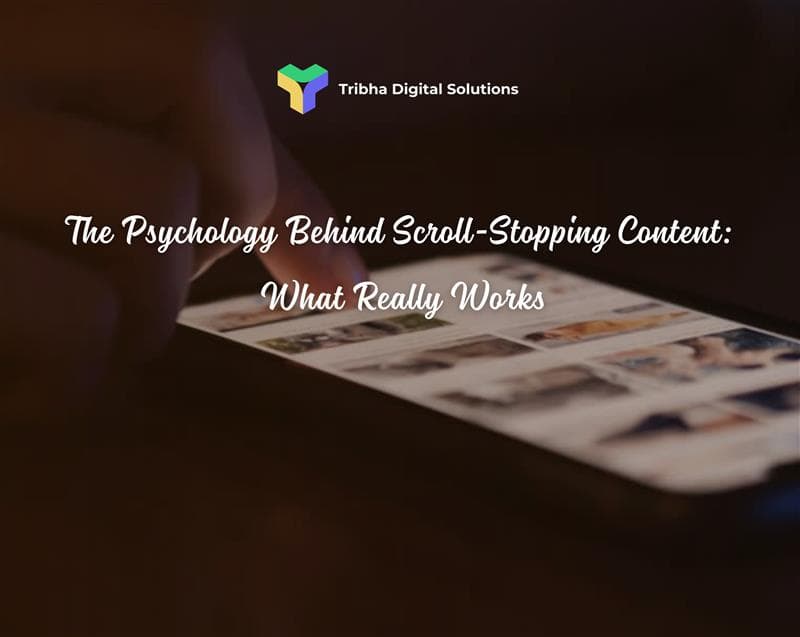The Psychology Behind Scroll-Stopping Content: What Works
“Wait, go back! What was that post?”“Which one?”
“That one with the dancing dog and the neon text—it just grabbed my attention!”
Sound familiar?
In a world where attention spans are shorter than ever (some say even shorter than a goldfish’s!), grabbing eyeballs online is no longer about luck — it’s about understanding the brain. If you want your audience to pause, engage, and interact, you need more than creativity. You need psychology.
Welcome to the science of scroll-stopping content — the kind that makes someone pause mid-scroll, feel something, and take action. But what really works behind the scenes? Let’s uncover it.
- The Brain Craves Novelty
Our minds are wired to respond to what's new or unexpected. Psychologists call this the orienting response—a survival instinct that helps us react quickly to changes.
In the content world, this could be:
- A black-and-white image in a sea of filters.
- A bold headline that contradicts the norm.
- An opening line like: “Why your marketing strategy is failing, and it’s not what you think.”
These pattern interrupts make the brain pay attention, even if just for a second.
Real-time tip: Use unique angles or formats that break the visual flow of your audience’s feed.
- Curiosity Gap: The Brain’s Unfinished Business
One of the strongest psychological triggers for engagement is curiosity.
Ever read a headline like: “She opened the door and froze…”
This taps into the curiosity gap — the space between what we know and what we want to know. Until that gap is closed, the brain stays hooked.
Apply this principle in:
- Blog headlines
- Email subject lines
- Social media captions
- Carousel intros
But always follow through. Clickbait may grab attention, but trust keeps it.
- Emotions Drive Action — Not Just Logic
Emotions shape how we see the world, make decisions, and remember stories. This is why people engage with emotional content more than purely informative posts.
Emotional triggers to play with:
- Happiness: Celebrations, wins, joy.
- Fear: Warnings, risks, consequences (balanced with solutions).
- Surprise: Unexpected results or stats.
- Anger or injustice: Issues that provoke thought or action.
- Inspiration: Stories that uplift or show transformation.
Real-time tip: Combine visuals with compelling captions that tap into emotions.
- Faces and Eye Contact Capture Attention
The human brain is wired to notice faces first. Eye contact, especially in videos or images, creates an instant connection and draws focus.
- Close-up shots of faces perform better in social ads.
- Authentic expressions drive empathy.
- Videos with people talking directly to the camera stop the scroll faster.
Tip: Use authentic human visuals over generic stock photos.
- Colors Influence Perception
Colors evoke psychological responses. For example:
- Red: Urgency, excitement.
- Blue: Trust, calm.
- Yellow: Optimism, warmth.
- Black: Power, luxury.
Tip: Align colors with the emotion you want your audience to feel.
- Social Proof Builds Trust
People trust other people more than brands. Adding proof reassures them.
- Testimonials
- Case studies
- User-generated content
- Numbers (e.g., “Over 10,000+ downloads”)
Tip: Highlight real people using your brand, not just polished ads.
- Urgency & FOMO Trigger Immediate Action
Deadlines and scarcity make people act faster.
- “Limited-time offer”
- “Only 3 seats left”
- Countdown timers
Tip: Use urgency sparingly to keep it authentic.
- Storytelling Triggers Memory
The brain remembers stories up to 22x more than facts alone. Narratives make your brand relatable and memorable.
- Use a hero (customer, founder, employee).
- Show a struggle and resolution.
- Make it emotional.
- Short-Form Content Fits Modern Attention Spans
TikToks, Reels, Shorts — they win because the brain prefers quick, digestible content.
- Hook in the first 3 seconds.
- Keep text punchy.
- End with a CTA.
- Repetition Builds Familiarity
The mere-exposure effect shows people trust what they see often. Repetition breeds familiarity and comfort.
Tip: Repeat your key brand phrases, colors, or taglines consistently.
- Contrast Makes Content Pop
Our brains notice contrast immediately — light vs. dark, bold vs. subtle.
- Dark background + neon text
- Minimalist post after a series of busy ones
- A simple line drawing among colorful graphics
- Consistency Wins Long-Term
Psychology doesn’t just stop the scroll once. Long-term engagement comes from showing up consistently.
- Post regularly
- Keep your tone consistent
- Maintain brand personality
Conclusion
Scroll-stopping content isn’t about flashy gimmicks. It’s about understanding human psychology. Novelty, curiosity, emotions, urgency, and storytelling work because they align with how our brains are wired. When you design content with these principles, you don’t just grab attention — you keep it.
